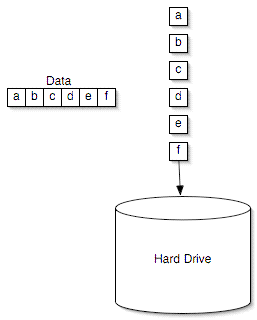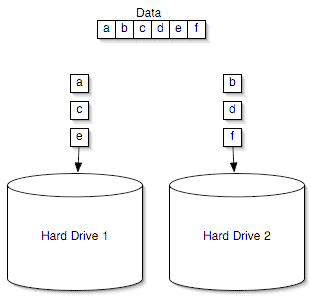Western Digital's Raptors in RAID-0: Are two drives better than one?
by Anand Lal Shimpi on July 1, 2004 12:00 PM EST- Posted in
- Storage
Doubling Theoretical Performance: RAID-0
For those of you who are already familiar with RAID and how it works, go ahead and skip to the benchmarks; these next two pages are designed to serve as brief introductions to the two most common forms of RAID on the desktop: RAID-0 and RAID-1.Otherwise known as striping, RAID-0 is the only performance-enhancing form of RAID that we'll be talking about in this article. The premise behind striping is simple. Data being written to a drive is split into "stripes", generally 16 - 256KB in size, with each stripe being written to a different drive in the array. For example, say we were dealing with a 2-drive RAID-0 array with a stripe size of 128KB and we wanted to write 256KB of data; drive 0 would get the first 128KB of data written to it, and drive 1 would get the remaining 128KB.

Writing to a single hard disk

Writing to a two-disk RAID-0 array
Here, you can see that the write performance of RAID-0 can be almost double that of a single drive, since twice as much data gets written at the same time. The higher write performance is obtained at the expense of some controller overhead, since the RAID controller has to handle splitting up data into stripes before sending it to the drives themselves - but with modern day microprocessors being as fast as they are, the overhead is usually thought of as negligible.
Reading works the exact same way, but in reverse. Say that we want to read that same 256KB of data back; we pull one stripe from drive 0 and the other stripe from drive 1. The read is now completed in half the time, theoretically doubling performance.
We are careful to use the word "theoretical" because the performance advantages of RAID-0 disappear quickly if we're not dealing in ideal situations like the ones we just described. If too large of a stripe size is used, then the performance advantages of RAID-0 can be lost, while too small of a stripe size could result in excess overhead, reducing the performance improvement of the striped array.
We have seen in the past that for most desktop applications, the largest stripe size that a desktop RAID controller will offer is usually the best choice for performance. With Intel's ICH5/6, that translates into a 128KB stripe size, which for our comparison is what we decided to go with. The other stripe size options didn't offer any better performance for our desktop test suite.
The main downside to RAID-0, other than cost, is reliability. The size of a RAID-0 array is the sum of all of its members; so, two 100GB drives in a RAID-0 array will give you one array with a 200GB total capacity. Unfortunately, if you lose any one of the drives in the array, all of your data is lost and isn't recoverable. Since two drives are working in tandem and are both necessary to hold your data, you effectively halve the mean time between failure by moving to a two-drive RAID-0 array.










127 Comments
View All Comments
Denial - Friday, July 2, 2004 - link
A$$ Masher,You seem to be the only person turned on by my system. Sorry, but I don't swing that way. You'll have a better chance at the internet cafes over in Chelsea.
TheCimmerian - Friday, July 2, 2004 - link
...Anyone have any thoughts on RAID0 for DV capture/editing/rendering?...masher - Friday, July 2, 2004 - link
#71, the statistics and applicability for MTBF and MTTF are a bit complex...so much so that most drive manufacturers themselves usually don't apply them properly (or intentionally mislead people).Technically, you're correct...RAID0 doesn't halve MTBF. However, for what the average user means by "chance of failure", a two-disk Raid0 array does indeed double your chance of a failure.
As to your comment of Raid-0 loading maps faster...true if its a large file (10MB+) and probably not discernably noticeable till you're in the 20-40MB range. For tiny files or heavily fragmented ones, it may even be slower.
Z80 - Friday, July 2, 2004 - link
This article was very informative. However, the statements that RAID0 cuts MTBF in half and that RAID1 doubles MTBF are statistically incorrect. Also, RAID0 does improve game performance especially when large game maps are involved (i.e., BF1942, BF Vietnam, Far Cry). It definitely provides an advantage in online FPS games by loading large maps faster and giving RAIDO equipped players an advantage in first choice for weapons and position. Your tests probably didn't measure map loading times.GokieKS - Friday, July 2, 2004 - link
"What's the difference between losing one 74gig Raptor in RAID-0 array or one 160gig stand-alone drive? THERE IS NO DIFFERENCE!"There is. The chance of you getting a HDD failure increases with every drive you add. A 2 disk RAID-0 array will have the same chance at failure as 2 independent non-RAIDed drives. The difference is, with the independent drives, you lose one drive's worth of data when it fails. With the RAID-0 array, you lose two.
~KS
sparky123321 - Friday, July 2, 2004 - link
I keep hearing about double the cost and the additional risk associated with a RAID-0 array.First off, double the price gets you DOUBLE the capacity of a single drive. It's a wash price wise. On top of that, you increase disk performance by up to 20+%. Normally, there tends to be a decrease in performance as capacity increases when comparing similar generation drives.
Secondly, with regard to risk. What's the difference between losing one 74gig Raptor in RAID-0 array or one 160gig stand-alone drive? THERE IS NO DIFFERENCE! If you don't have a recent backup, you've lost everything. Just spend an additional $90 to buy a backup 160gig 7200rpm IDE and use Acronis to do a complete disk mirror every week or two. If you lose a RAID-0 drive, you can just boot off of the backup drive and be up and running in a matter of minutes. Worst case, you've lost you're most recent work only.
Power to the Raptors and I think I'll stick with my RAID-0 array!!!!!!!
abocz - Friday, July 2, 2004 - link
I think #63 summed it up pretty well. For most real world usage the RAID0 setup never gets to shine because of the ratio of seek times/data transfers. Lower (7200) RPM drives will only compound the situation since their seek times are worse. Finally, add to this phenomenon the fact that the ratio of seeks will increase over time as fragmentation increases.Which begs the question of how well defraggers work in a RAID 0 setup? Anybody know?
Inferno - Friday, July 2, 2004 - link
Maybe you should try this test with some lesser drive. The raptors are kind of the be all end all drives. Maybe a pair of midrange Maxtors.binger - Friday, July 2, 2004 - link
#61, jvrobert is right in saying that the advantages of a raptor-raid0 are restricted to faster boot-up times and smoother handling of very large files, eg when it comes to dv.although i have heard similar statements before, whether a raid0-array of two 160gb samsung drives comes close to the performance of a single 74gb raptor drive, i don't know - i would surely appreciate being pointed to an appropriate review or at least a couple of significant benchmark results.
jvrobert - Friday, July 2, 2004 - link
Two points:First, it doesn't matter much what card you use for RAID 0. There's no parity calculation, so onboard hardware won't help much. Probably Windows striping, Intel RAID, VIA RAID, Highpoint RAID, etc.. are within 1 percent of eachother.
Second, this is a limited test that comes to an overgeneralized conclusion. As some have mentioned - these are raptors. I have a single raptor as my OS disk. Where RAID helps is with slower drives - you can get a "virtual" raptor of e.g. 360GB by buying 2 cheap, quiet, cool Samsung spinpoints.
Third (OK, 3 points) - it only tests games (which don't use much hard disk IO) and business (again, disk speed doesn't matter much). I'm getting into video now, and RAID 0 will certainly improve performance there. It will also help with load times of the OS and of large applications.
So the article comes to an over-general conclusion limited on a few quick tests.